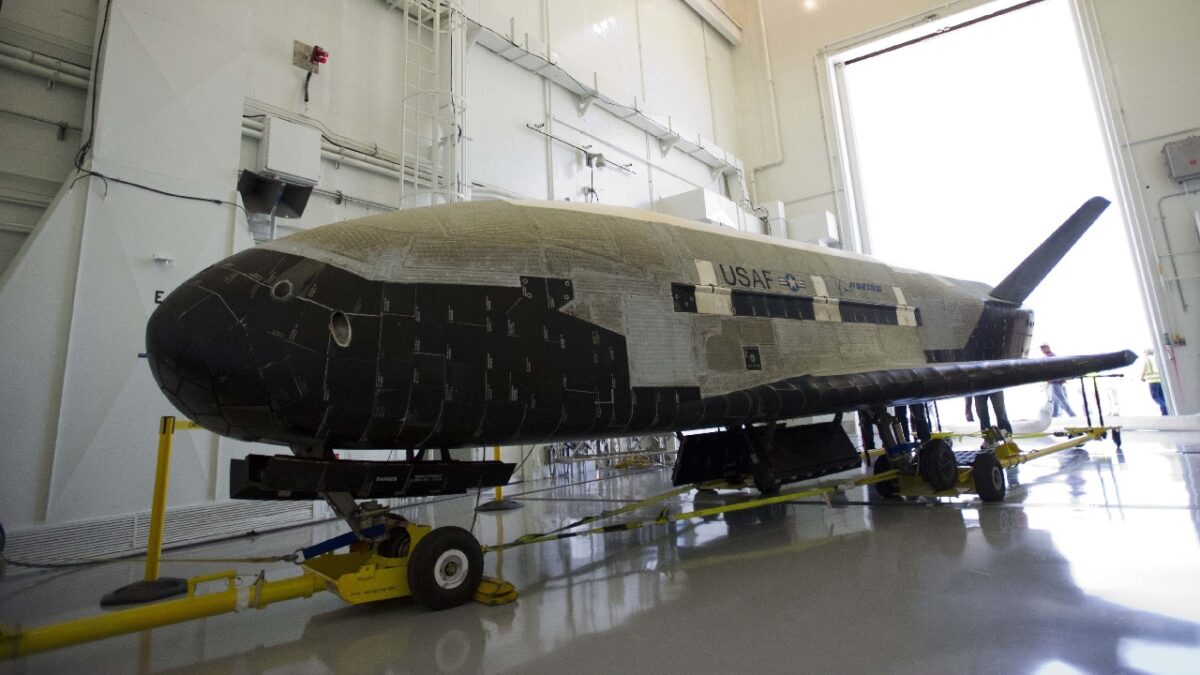What goes up usually comes down. But when the United States Space Force’s secret X-37B robotic space plane returns to Earth could be anyone’s guess. Earlier this week, it reached a new milestone – having passed 900 days in orbit on its “hush-hush” mission that began when it was launched on May 17, 2020, from Cape Canaveral Space Force Station, Florida.
Orbital Test Vehicle 6 (OTV-6), as the sixth and current mission, is officially known, is the first to use a service module to host experiments. That component is an attachment to the aft of the vehicle that allows additional experimental payload capability to be carried to orbit. It has been reported that two of the NASA experiments were to study the results of radiation and other space effects on materials sample plates and seeds that could be used to grow food.
In addition, the mission also deployed the FalconSat-8, a small satellite developed by the United States Air Force Academy and sponsored by the Air Force Research Laboratory to conduct further experiments. In many ways, the X-37B is allowing researchers to carry out experiments in orbit, even more than a decade since the Space Shuttle program ended.
Record-Setting Mission for X-37B
The X-37B was used in five previously successful missions, and each had superseded the previous one in terms of time spent in orbit. The initial mission in 2010 lasted less than a year, while the second mission spent 468 days in orbit before returning to Earth. OTV-3 went on to spend a total of 674 days in orbit, and OTV-4 reached spent 718 in orbit. That fourth mission was also notable for being the first to land at the Kennedy Space Center in Florida.
The most recent previous mission, OTV-5, was launched into orbit in September 2017 and it spent 780 days circling the Earth. The latest record could be especially hard to surpass.
Flying High
The X-37B Orbital Test Vehicle (OTV) was developed by Boeing for the United States Air Force as an experimental test program to demonstrate technologies for a reliable, reusable, unmanned space test platform. Its primary objectives are to test reusable spacecraft technologies for America’s future in space and for operating experiments, which can be returned to and examined on Earth.
NASA’s original X-37 program began in 1999 and was transferred to DARPA in 2004. It is now under the domain of the United States Space Force’s Delta 9, which was established and activated on July 24, 2020.
The X-37B isn’t the only space plane currently in orbit, however, as China launched its own orbiter on August 4. That mission is even more under wraps than the U.S. program. It isn’t surprising that Beijing has taken such an interest in the program – as some Chinese officials have suggested the X-37B could be used with aggressive intent – including dropping bombs or disabling enemy satellites as it circles the globe.

The X-37B Orbital Test Vehicle (OTV), the Air Force’s unmanned, reusable space plane, landed at Vandenberg Air Force Base at 5:48 a.m. (PDT) June 16. OTV-2, which launched from Cape Canaveral Air Force Station, Fla., March 5, 2011, conducted on-orbit experiments for 469 days during its mission. The X-37B is the newest and most advanced re-entry spacecraft. Managed by the Air Force Rapid Capabilities Office, the X-37B program performs risk reduction, experimentation and concept of operations development for reusable space vehicle technologies. (photo credit: Boeing)

X-37B. Image Credit: Boeing.

In a testing procedure, the X-37B Orbital Test Vehicle taxis on the flightline March 30, 2010, at the Astrotech facility in Titusville, FLa. (Courtesy photo)
However, based on the current mission, it seems that the X-37B isn’t actually a weapon and instead is carrying on where the Space Shuttle left off.
A Senior Editor for 19FortyFive, Peter Suciu is a Michigan-based writer. He has contributed to more than four dozen magazines, newspapers, and websites with over 3,000 published pieces over a twenty-year career in journalism. He regularly writes about military hardware, firearms history, cybersecurity, and international affairs. Peter is also a Contributing Writer for Forbes and Clearance Jobs. You can follow him on Twitter: @PeterSuciu.
19FortyFive is committed to providing you with the best defense, national security, politics, and economics analysis. Follow us on Google News, Flipboard, YouTube, Facebook, Twitter, and Linkedin. Also, sign up for our newsletter here. You can also find our code of publishing ethics and standards here. Want to contact us? Email: [email protected].

